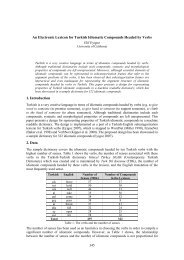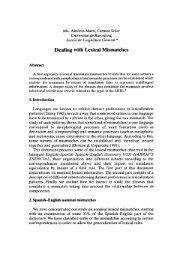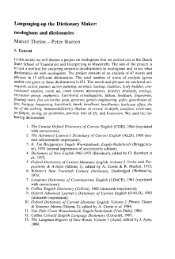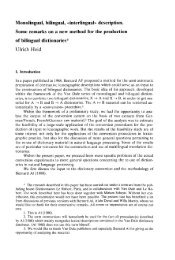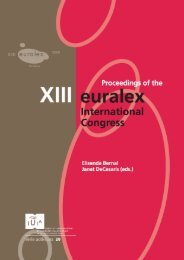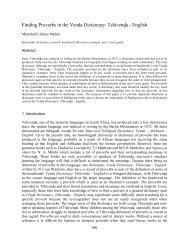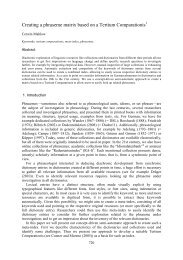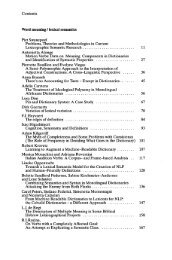Collocations in a New Bilingual Print and Electronic English - Euralex
Collocations in a New Bilingual Print and Electronic English - Euralex
Collocations in a New Bilingual Print and Electronic English - Euralex
You also want an ePaper? Increase the reach of your titles
YUMPU automatically turns print PDFs into web optimized ePapers that Google loves.
WORKSHOP ON COLLOCATIONS<br />
The Function of <strong>Collocations</strong><br />
We have shown that, because of the syntactic <strong>and</strong> semantic dimension that collocations<br />
display, they must be listed <strong>and</strong> translated fully <strong>in</strong> their function as important syntactic units<br />
to learn. Also, bases of collocations can be more effective mean<strong>in</strong>g discrim<strong>in</strong>ators than<br />
synonym glosses, which can be too vague. If the base is easy- to translate or if it is the<br />
superord<strong>in</strong>ate for a whole range of collocates (e.g. person, build<strong>in</strong>g, etc.) then the full<br />
collocation need not be listed. Restrictedness is therefore also a criterium for the way <strong>in</strong><br />
which collocations are shown. The way collocations are <strong>in</strong>cluded is also subject to space-<br />
sav<strong>in</strong>g criteria <strong>in</strong> pr<strong>in</strong>t dictionaries. In addition L1 <strong>and</strong> ease of translation <strong>in</strong>to L2, <strong>and</strong><br />
aesthetic criteria such as a dictionary style that is as natural as possible will be <strong>in</strong>fluential.<br />
Access<strong>in</strong>g <strong>Collocations</strong> <strong>in</strong> Dictionaries<br />
Because of the dual dimension of collocations, they must be accessible both under base <strong>and</strong><br />
collocator headwords <strong>in</strong> a general bil<strong>in</strong>gual dictionary [see Cop 1991, 2777]. We therefore<br />
disagree with Hausmann's view that collocations should be cross-referred from collocator to<br />
base entries [Hausmann 1988, 151] where they are needed for text production, firstly<br />
because this would cause a cross-reference <strong>in</strong>flation which is not user-fřiendly. Secondly,<br />
they are equally needed <strong>in</strong> collocator entries to help illustrate the sense of the collocator<br />
be<strong>in</strong>g treated. Luckily, this has become possible with the advent of electronic dictionaries<br />
[Petelenz 2001, 188 f. <strong>and</strong> Heid 1998].<br />
The electronic version of PGE, Lexiface Professional [PLP], shows the content of PGE <strong>in</strong><br />
electronic form <strong>and</strong> <strong>in</strong>cludes a pop-up function. It is a first project on the road to the<br />
realization ofa fully electronic dictionary.<br />
Endnotes<br />
1 German-<strong>English</strong>: Schöffler Weis Taschenwörterbuch der englischen und deutschen Sprache (1950);<br />
German-French: Weis Mattutat: Taschenwörterbuch Deutsch-Französisch (1951)<br />
" For the comb<strong>in</strong>ation <strong>English</strong>-German, this means that only <strong>English</strong> native speakers work on the<br />
<strong>English</strong> material while only German natives work on the German.<br />
'" The word clean is autosemantic <strong>in</strong> its ma<strong>in</strong> mean<strong>in</strong>g - "not dirty". This can be demonstrated by the<br />
fact that it is fairly easy to guess the word from its def<strong>in</strong>ition. In other senses, however, it is also<br />
synsemantic. Ifsomeone supplied a def<strong>in</strong>ition such as "free from previous crim<strong>in</strong>al offence" one<br />
would probably not come up with the with the word <strong>in</strong> question, i.e. clean [Hausmann 1997].<br />
IV In Mel'cuk's term<strong>in</strong>ology Magn(x).<br />
v Other common lexical functions, apparent <strong>in</strong> adverbs are praise, e.g. cordially <strong>in</strong>vite, to perform<br />
beautifully, th<strong>in</strong>k creatively, <strong>and</strong> dim<strong>in</strong>ishers, e.g. barely visible, hardly ever, rarely seen, to perform<br />
poorly.<br />
V1 Cowie's three possibilities <strong>in</strong>clude us<strong>in</strong>g semantic characteristics (e.g. + film or + music), an<br />
archilexeme - a word cover<strong>in</strong>g a lexical field (e.g. event) or list<strong>in</strong>g a representative selection ofbases<br />
as here shown.<br />
v " Cowie set his criteria with monol<strong>in</strong>gual L2 dictionaries <strong>in</strong> m<strong>in</strong>d. Acknowledg<strong>in</strong>g this, we would<br />
like to illustrate <strong>in</strong> this paper that Cowie's three possibilities all have a place <strong>in</strong> the bil<strong>in</strong>gual<br />
dictionary.<br />
805



